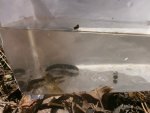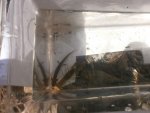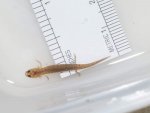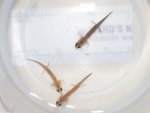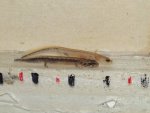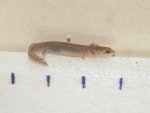Based on the lengths of the four toes on the hind feet that I can see, I'll bet that there is a 5th toe back there. The "thumb" of the foot, the toe closest to the body, can be tricky to spot in larvae.
Traxolotl is right about it being a
Eurycea. And I'm willing to bet, based on your range and these photos, that it's a two lined salamander (
Eurycea cirrigera,
Species Profile: Southern Two-lined Salamander (Eurycea cirrigera) | SREL Herpetology). But a closer dorsal shot, and or a lateral shot, would help me be certain. I know good shots can be tricky to get, but you could try putting it in a container with shorter sides so your camera could get closer to the animal.
Meanwhile, look at the pattern on the back (dorsal) and on the sides (lateral). Is there a row of small, light dots or spots dorsolaterally on each side (see the first photo)? These are often characteristic of
E. cirrigera, and can be as small as pin-pricks in very dark or very light individuals. The light spots or dots are actually clusters of irridophores around the lateral line organs. But sometimes you can get similar dots in three lined salamander larvae (
Eurycea guttolineata, see uppermost individual the second photo). However, if they are
E. guttolineata, the sides will likely have a band that is more darkly pigmented (see lower individual in photo three), or, if the individual is lacking in overall pigment, the band may be reduced on the body, and may form a barred pattern on the tail (kind of visible in the upper individual in photo three). The lateral pattern in
E. cirrigera is different. There is more streaking or mottling, and a less uniform wash of dark color, the pigment is typically less dense (see photo four). Larval
E. cirrigera are highly variable, too. In extremely pale individuals, the pinprick dorsolateral spots can help identify them. Also, as you should be able to see from the photos,
E. cirrigera have less pigment on the face than do
E. guttolineata.


